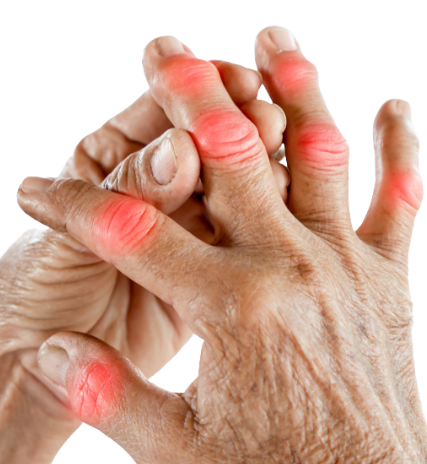Trigger Finger & Trigger Thumb
About Trigger Finger & Trigger Thumb
Trigger finger or trigger thumb occurs when your fingers or thumb get stuck in a bent position – like you’re squeezing a trigger. People with trigger fingers or trigger thumb may feel stiff when bending their fingers or hear snapping or popping noises when moving their fingers. According to statistics, 2 out of 100 people suffer from trigger finger, which is more common in women aged 40 and older with diabetic conditions.
What Causes Trigger Finger
The finger consists of various appendages, each of these appendages is connected by tendons from muscle to bone. The tendons and muscles of the hand work together to straighten your fingers and thumb. Normally, tendons slide easily through a tunnel of tissue known as a sheath. Trigger finger and trigger thumb are characterized by irritated and swollen tendons which can no longer easily slide through the sheaths.
Trigger finger or trigger thumb are most commonly found in:
- Housewives, Cooks
- Cleaners who experience repetitive strain on their fingers
- Manual labourers such as Industrial workers
- People with osteoarthritis, gout or diabetes
- People between the ages of 45 and 60

What Causes Trigger Finger
The finger consists of various appendages, each of these appendages is connected by tendons from muscle to bone. The tendons and muscles of the hand work together to straighten your fingers and thumb. Normally, tendons slide easily through a tunnel of tissue known as a sheath. Trigger finger and trigger thumb are characterized by irritated and swollen tendons which can no longer easily slide through the sheaths.
Trigger finger or trigger thumb are most commonly found in:
- Housewives, Cooks
- Cleaners who experience repetitive strain on their fingers
- Manual labourers such as Industrial workers
- People with osteoarthritis, gout or diabetes
- People between the ages of 45 and 60
Symptoms Of Trigger Finger and Trigger Thumb
Inability to grip objects or close the hand fully
Finger pops
Pain and stiffness
Swelling
When Should I Seek Medical Attention?
You should seek medical help when:
- Inability to grip objects or close the hand fully
- Fingers are locked in place and stiff
- Finger pops when fists are clenched
- Unable to straighten the finger
- Any other similar conditions
A Message About Trigger Finger
Trigger finger/thumb is a result of overuse syndrome. Repetitive strain will cause friction of the tendon sliding over the pulley sheath that holds it in place. Once injury sets in, inflammation will cause swelling of the affected part of the tendon – usually distal to the pulley, nearing into the finger.
Trigger finger if treated early, can achieve full recovery with simple injection treatment. Myospan treatment using a mix of local anaesthetic, anti-inflammatory and muscle relaxant will provide almost immediate effective pain relief. Combined with physiotherapy, and stretching exercises, this condition can be prevented from recurrence.
If left untreated, the pain will progress to form a nodule – a painful lump of the inflamed tendon. That will be harder to treat and may need surgical excision of the nodule.
Diagnosing Trigger Finger & Trigger Thumb
Here at Singapore Paincare, our team of experienced primary care physicians and/or pain care specialists together with a hand surgeon will conduct a thorough diagnosis. This includes a physical exam, questions about your symptoms, and an evaluation of your medical history. The severity of your Trigger Finger will be categorized into 4 different grades based on your finger mobility and function.
What Treatments are Available for Trigger Finger & Trigger Thumb?
At Singapore Paincare, we strive to treat your pain with the least invasive option possible after accurately identifying the cause. Our approach to pain resolution focuses on the removal of pain generators via specialised injection and minimally invasive procedures. Combined with pharmacological treatments and cognitive and physical rehabilitative therapies, we help patients improve functions and prevent pain from recurring.
Non-Surgical Treatment for Trigger Finger & Trigger Thumb
Splinting
Steroid Injection
Surgical Treatment for Trigger Finger & Trigger Thumb
If non-surgical treatments are ineffective or the condition recurs, surgery may be recommended. As surgery always comes with associated risks, complications and downtime – it may not be suitable for everyone.
Trigger Finger Release Surgery
Home Remedies for Trigger Finger
As an initial reactive measure, let the injured finger rest and try not to move it so the inflammation may slowly disappear. Patients can also take anti-inflammatory painkillers. If the inflammation is not severe and not very painful.
During the recovery process, it is best to avoid re-injuring the inflamed tendon: not holding things tightly and not using tools or performing hand movements that need gripping actions would be beneficial.
If the fingers are stiff at night and pain is felt in the morning when straightening the fingers, it may be helpful to use a nightly splint to keep the fingers straight before going to bed.
Lastly, place a cold compress on the affected area and slowly stretch the affected fingers to speed up the healing.
How Can I Prevent Trigger Finger & Trigger Thumb?
Resting is the best thing you can do. You’re probably overworking your finger(s) and you need to give your body some time to recover. You can also wear a splint to bed to make sure that your fingers are able to recover.

Get Your Pain Resolved
Send your enquiries or consult our pain experts today.


